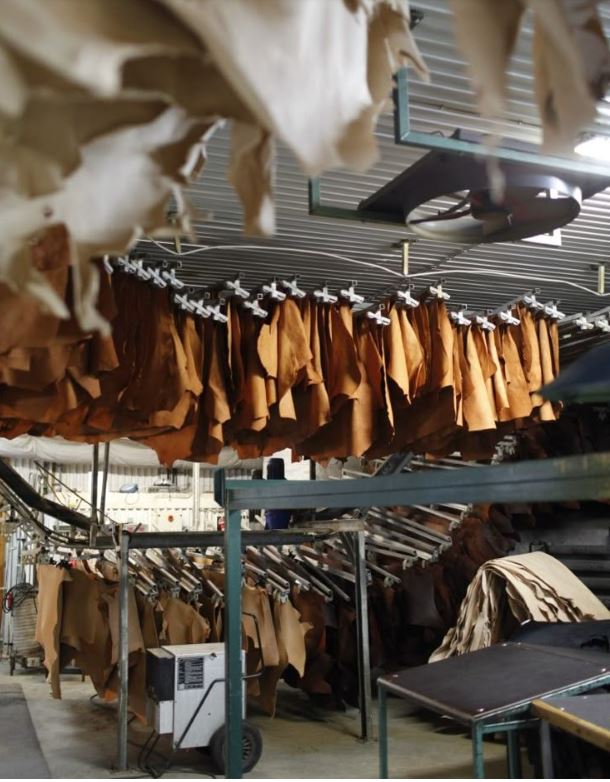The Leather Tanning Process

What is leather tanning?
Leather is such a popular material that many people around the world own at least one leather item. Maybe it’s because of the broad recognition and variety of leather products that tanning animal hides and turning them into leather has always been interesting to learn about.
Tanning is the process of converting animal hides into leather. It’s an old and technical process that can take anywhere from several days to several months, depending on whether hair is kept on the hide or not.
With the advent of machines, the natural leather tanning process has become a bit simpler over the years and across different countries, but many modern methods are still based on the ancient techniques passed down through generations.
How is leather tanning done?
Leather tanning does not require special or complicated tools. If you learn the multi-step technique, you can even tan hides with minimal equipment.
Leather has been with humans since the Stone Age, and from the beginning, it didn’t require complex tools. Patience and experience are the main “equipment” needed. Animal hides are turned into leather using either traditional or industrial methods.
Traditional tanning steps:
1- Initial cleaning of the hide
After selecting undamaged hides, they are thoroughly cleaned — hooves, ears, head, and any attached parts are carefully removed.
2- Preventing spoilage
Once the hide is fully cleaned, it must be quickly treated to prevent bacterial decay, as bacteria can start within five hours. Methods include:
Drying under the sun (oldest method, but depends on strong, dry sunlight; over-drying or uneven drying can harm the hide’s quality)
Quick freezing (stops spoilage but is costly and can damage tissue)
Salting/dry salting (covering the hide with salt and hanging it to dry; salt pulls out moisture and makes the hide highly resistant to humidity)
Salt bath (soaking hides in a highly concentrated salt solution; popular because it stops bacterial growth and prepares hides for tanning)
Controlled drying (using industrial dryers; fast and thorough but expensive)
3- Soaking and washing
Dried or salted hides are re-soaked in water for a long time to regain flexibility. This removes any leftover hair, tissue, or fat and softens the hide.
4- Dehairing and liming
Hides are treated with lime and sometimes barley flour to remove remaining hair and soften the fibers, making the hide easier to process.
5- Vegetable tanning
The oldest tanning method uses plant materials (like tannins) to prevent bacterial growth and color the leather in natural shades like yellow, brown, or red. This produces soft, strong leather.
6- Chemical tanning
Chrome salts: make leather soft, thin, and elastic
Alum (aluminum salts): produce white leather
Iron salts: used for specific treatments
7- Oil tanning
Uses oils, especially for hides like deer or goat, to make leather for gloves and garments.
8- Drying
The tanned leather is hung in the sun or passed through heated steel rollers in industrial settings to remove all moisture.
9- Dyeing, cutting, layering
Leather is cut into layers and dyed into desired colors. Thinner layers are used for gloves; thicker layers for boots or bags.
10- Oiling
The dried, dyed leather is stiff, so it’s treated with special oils (mineral or synthetic) to restore flexibility for cutting and sewing.
11-Softening
The leather is softened again, either by machine or by hand in traditional tanneries, preparing it for final use in products like bags, clothing, etc.
Summary of key leather stages:
Salambour: raw hide cleaned and salted for preservation (called “pickle” in English; acid and salt used after dehairing)
Wet blue: semi-processed leather, tanned with chrome salts, ready for further coloring and finishing
Crust: tanned and dried leather, not yet dyed, ready for printing or finishing (Italy, China, Spain, and Thailand are top importers; Nigeria, Italy, Bangladesh, and Egypt are major exporters; Turkey is a key buyer from Iran)
Finished leather: fully processed, dyed, and ready for industrial or consumer use
Difference between traditional and industrial tanning:
Tanning significantly improves leather’s durability. Untanned hides can’t withstand hot water, but tanned leather can handle temperatures up to 100°C.
The global demand for natural leather keeps growing, so relying solely on traditional tanning isn’t enough — but industrial methods bring their own challenges.
Leather production has ancient roots in Iran and around the world, and though it’s a hard and demanding process, it produces a valuable, high-priced material used not only for clothing but also in industries like shipbuilding, aviation, and automotive manufacturing.
To meet the expanding leather market, industrial methods help increase production speed and volume.
Hyrcania Treading Group
Contact us
+39 379 2548013
+39 351 5027937
Company Profile


